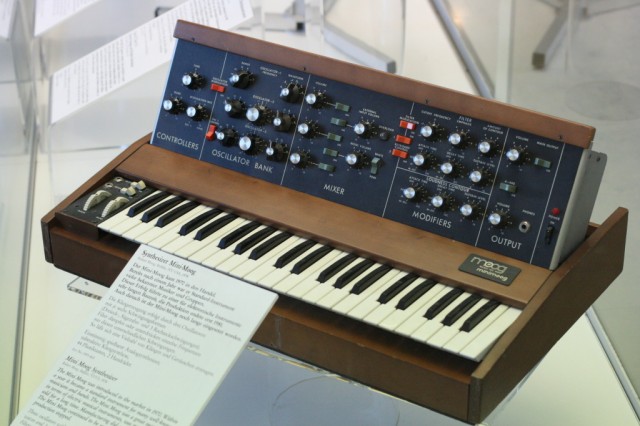
It wasn’t always like this. In fact, it was 50 years ago this year that, in 1964, a man by the name of Bob Moog unveiled a synthesizer of a very different sort. Called the Moog Modular, it is regarded as one of the first.
...
Some like to refer to the Theremin as the first electronic instrument. Lev Termen (or Léon Theremin), the Russian inventor after which the Theremin is named, invented the device in the early 1920s. It has two metal antennas that, based on the position of a person’s hands above the device, control the volume and pitch of an oscillator. In other words, the Theremin is played, not with any physical controls, but by waving your hands around in the ai
...
According to Analog Days, Deutsch first met Moog at a conference in 1963, where Moog was selling his company’s newly manufactured Theremin kits. Deutsch liked the Theremin, but what he really wanted was an instrument that would allow Deutsch to make “sounds with moving pitches,” according to Moog.
...
Much like Moog’s beloved Theremin, a synthesizer starts with an oscillator, which generates a basic waveform, or tone. There are a few waveforms you can choose from. A sine wave produces a pure tone, sort of like a whistle, Paradiso explained over the phone one afternoon, while a square wave is more like a reed instrument, such as a clarinet. A Triangle waveform is in between a sine and square, and it sounds akin to an organ, while a sawtooth waveform has a bright, saxophone-like sound. These tones are fine enough on their own, but Paradiso argued that what really gives an analog synthesizer its character and soul is when you put a filter on top.
“The filter gave the synth its timbre complexity and the timbre vocabulary that we see now,” Paradiso explained, referring to the unique characteristics that distinguish one sound or voice from another. “And of course, it’s the basis of what we call subtractive synthesis. It really brought the synthesizer to life.”
The filter’s job is to remove or subtract certain frequencies produced by the oscillator to create new, unique sounds. It’s largely responsible for shaping all of the different voices a synthesizer can make. And much like there are different types of oscillator waveforms from which to shape those sounds, there are different types of filters, too. A low pass filter allows low frequencies through while attenuating—or softening—higher frequencies. High-pass frequencies do the opposite, while a bandpass filter attenuates both high and low frequencies, allowing only those in the middle through.
When Paradiso says that filters bring a synthesizer to life, this was especially true in the case of early Moogs. It was the filter, the “crown jewel” of the Moog synthesizer, according to Analog Days. The filter was the source of the “‘rich,’ ‘fat,’ ‘juicy’ tone that nearly everyone refers to as the Moog sound.” Competitors tried copying it—it was that good.
After the oscillator’s output is sent through the filter, the end result arrives at the amplifier. This module dictates the loudness of a synthesizer’s output—the sound you actually hear. But here it’s important to mention a fundamental feature of Moog’s early synthesizer design: voltage control.
Voltage control wasn’t a new concept at the time, but the way Moog applied it to the operation of an electronic instrument was. Basically, Moog defined a standard whereby, instead of controlling the pitch of the oscillator manually with a knob or via the movement of your hands as you would a Theremin, an oscillator could be manipulated using electrical control. To move between octaves, you would either increase or decrease the supplied current by one volt.
“Bob worked with musicians from the get go, so he designed his oscillators with exponential converters built right in,” Paradiso explained. “You put in a linear voltage coming off a regular linear keyboard, where it’s just one volt per octave. It goes up in a linear fashion, and the oscillator would double for every volt of the frequency.”
In other words, each key on Moog’s keyboard controller triggered a specific voltage which corresponded to a different frequency, essentially allowing the oscillator to be played one note at a time. But voltage control could do other things, too. It was, essentially, a means of controlling all sorts of synthesizer functions, beyond mere pitch. For example, Moog built something called an envelope generator that controlled the volume of the amplifier. Using voltage control, you could use the envelope generator to shape the sound of a note over time, from when you first pressed a key, to when you lifted your finger, and everything after and in-between. You could make each note ring out for seconds or die down almost immediately with a thunk. Nowadays these characteristics are commonly referred to as attack, decay, sustain, release, or ADSR.
Though far from polished, this is the basis of what Moog came up with over the course of 1964. The basic modules of Moog’s modular synthesizer—the voltage controlled oscillator (VCO), voltage controlled filter (VCF), and voltage controlled amplifier (VCA)—began to take shape.
Link to article